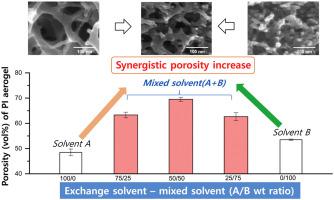Polymer ( IF 4.6 ) Pub Date : 2020-08-01 , DOI: 10.1016/j.polymer.2020.122879 Dae Ho Lee , Moon Jung Jo , Se Won Han , Seunggun Yu , Hoyyul Park

|
Despite intensive studies on polymer aerogels, the fabrication of polyimide aerogels mostly relies on supercritical drying; however, the development of suitable ambient or vacuum drying methods and a shortened solvent exchange process are important for industrial applications. This study highlights the effect of the solvent type used for the solvent exchange process on the porosity and pore structure of vacuum-dried polyimide aerogels. By combining two different solvents, we could achieve a much higher aerogel porosity than when using either solvent independently. This synergistic effect cannot be simply explained by the surface tension of the exchange solvent but is shown to be related to the solvent–polymer affinity, solvent-induced structural change during the solvent exchange process, and shrinkage behavior during the solvent exchange and drying processes. The pore structure and porosity are shown to be easily controllable by simply adjusting the solvent ratios. Moreover, the solvent exchange time is much shorter (~10 h) than that in previous reports on polyimide aerogels, which is highly beneficial for industrial application. The mechanical properties were highly dependent on the porosity and pore structure, and the relative permittivity could be adjusted in a wide range according to the controlled porosity. Together with high thermomechanical stability, various electronic applications are expected. Moreover, the idea proposed in this study is expected to serve as a useful guideline for the fabrication of various other polymer aerogels with efficient processability.
中文翻译:

孔隙率可控的聚酰亚胺气凝胶:溶剂交换过程中溶剂诱导的协同孔发展
尽管对聚合物气凝胶进行了深入研究,但聚酰亚胺气凝胶的制造主要依靠超临界干燥。然而,对于工业应用而言,开发合适的环境或真空干燥方法以及缩短溶剂交换过程至关重要。这项研究强调了用于溶剂交换过程的溶剂类型对真空干燥的聚酰亚胺气凝胶的孔隙率和孔结构的影响。通过组合两种不同的溶剂,与单独使用两种溶剂相比,我们可以获得更高的气凝胶孔隙率。这种协同作用不能简单地用交换溶剂的表面张力来解释,而是与溶剂-聚合物的亲和力,溶剂在交换过程中引起的结构变化有关,在溶剂交换和干燥过程中的收缩行为。通过简单地调节溶剂比率,显示出可容易地控制孔结构和孔隙率。此外,与以前关于聚酰亚胺气凝胶的报道相比,溶剂交换时间要短得多(〜10小时),这对工业应用非常有利。力学性能高度依赖于孔隙率和孔隙结构,相对介电常数可以根据控制的孔隙率在很宽的范围内调节。连同高的热机械稳定性,期望各种电子应用。此外,本研究中提出的想法有望作为有用的指南,用于制造各种其他具有有效加工性能的聚合物气凝胶。通过简单地调节溶剂比率,显示出可容易地控制孔结构和孔隙率。此外,与以前关于聚酰亚胺气凝胶的报道相比,溶剂交换时间要短得多(〜10小时),这对工业应用非常有利。力学性能高度依赖于孔隙率和孔隙结构,相对介电常数可以根据控制的孔隙率在很宽的范围内调节。连同高的热机械稳定性,期望各种电子应用。此外,本研究中提出的想法有望作为有用的指南,用于制造各种其他具有有效加工性能的聚合物气凝胶。通过简单地调节溶剂比率,显示出可容易地控制孔结构和孔隙率。此外,与以前关于聚酰亚胺气凝胶的报道相比,溶剂交换时间要短得多(〜10小时),这对工业应用非常有利。力学性能高度依赖于孔隙率和孔隙结构,相对介电常数可以根据控制的孔隙率在很宽的范围内调节。连同高的热机械稳定性,期望各种电子应用。此外,本研究中提出的想法有望作为有用的指南,用于制造各种其他具有有效加工性能的聚合物气凝胶。与以前关于聚酰亚胺气凝胶的报道相比,溶剂交换时间要短得多(约10小时),这对工业应用非常有利。力学性能高度依赖于孔隙率和孔隙结构,相对介电常数可以根据控制的孔隙率在很宽的范围内调节。连同高的热机械稳定性,期望各种电子应用。此外,本研究中提出的想法有望作为有用的指南,用于制造各种其他具有有效加工性能的聚合物气凝胶。与以前关于聚酰亚胺气凝胶的报道相比,溶剂交换时间要短得多(约10小时),这对工业应用非常有利。力学性能高度依赖于孔隙率和孔隙结构,相对介电常数可以根据控制的孔隙率在很宽的范围内调节。连同高的热机械稳定性,期望各种电子应用。此外,本研究中提出的想法有望作为有用的指南,用于制造各种其他具有有效加工性能的聚合物气凝胶。相对介电常数可根据控制的孔隙率在较宽的范围内调节。连同高的热机械稳定性,期望各种电子应用。此外,本研究中提出的想法有望作为有用的指南,用于制造各种其他具有有效加工性能的聚合物气凝胶。相对介电常数可根据控制的孔隙率在较宽的范围内调节。连同高的热机械稳定性,期望各种电子应用。此外,本研究中提出的想法有望作为有用的指南,用于制造各种其他具有有效加工性能的聚合物气凝胶。


























 京公网安备 11010802027423号
京公网安备 11010802027423号